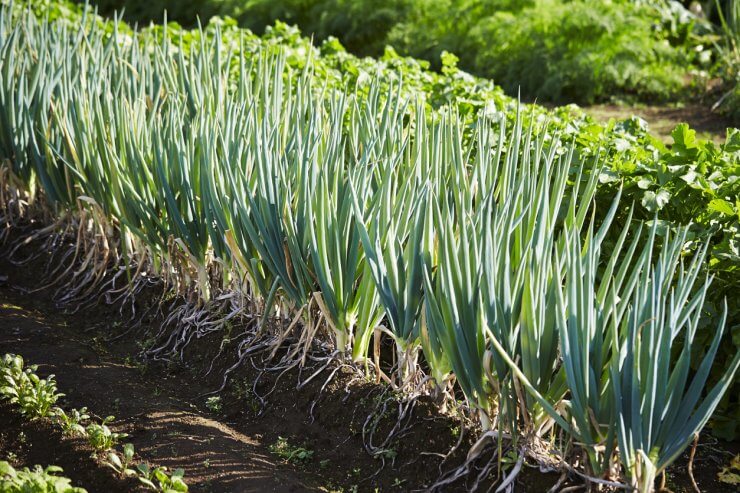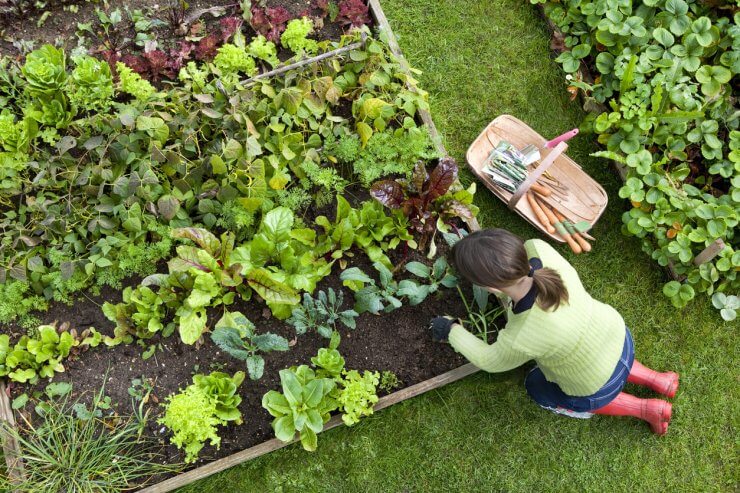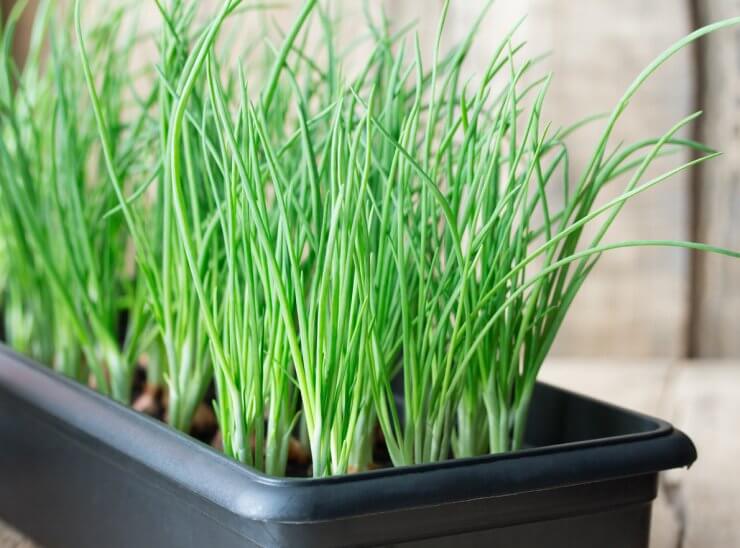
Scallions in open land
When you’re planning your scallion garden, consider the type of land you can tend. If you already have a plot of land with rich soil, good drainage, and optimal sun exposure, then planting directly in the ground would be a great option for you. But if, once you’ve had your soil analyzed (which we highly recommend), if it’s going to be more work to amend the soil to get it just the right composition and pH, consider planting in raised beds. If you’re short on yard space, if you don’t have much of a yard, or if you prefer to keep your growing efforts in close proximity to your kitchen, consider planting in containers or pots.
Growing in Raised Beds

A woman tending scallions in her raised bed
There is no arguing that setting up raised garden beds for the first time can be a pain in the back, among other things. But raised beds provide great advantages: you control the soil composition, it’s easier to weed and water, and harvesting is easy. Raised beds are a great garden addition for anyone with limited mobility, too. And once you’ve set up your raised beds, all you need to do is give the soil some TLC every season and you’ll be in great shape.
You can build raised beds from raw materials, purchase the components from your local garden store, or use a combination of specialized raised bed parts and your own material for the sides.
One great benefit of having raised beds is that you are likely to need to do less weeding—providing you use weed-free soil to start off your growing area. With fewer weeds, you’ll need to do less weeding—good news for your crops and your back!
Annual Tip: To optimize the soil in your raised beds, be sure to amend your soil with compost at least once a year—otherwise, your soil can become less productive for your plants.
Growing Scallions in Containers or Pots

Scallions growing in a planter box
Not all of us have the luxury of a sprawling yard with optimal soil for gardening—or enough space to set up raised beds for gardening.
Containers to the rescue! Turn your deck or balcony into a refreshing retreat—one that will provide some of your ingredients for dinner! You can move the containers exactly where you need them for just the right amount of sunlight.
Tip: If you have trouble moving pots around, because they’re too heavy or too bulky, try putting your pots on slightly raised rolling casters so you can more easily move them around your space.
Gardening in containers makes weeding a breeze. On the other hand, it makes watering properly a top priority. It can be too easy to let your pots go dry or to kill your plants with kindness and water. Containers can dry out much faster than soil in a raised garden bed or in a regular garden plot, so just be sure to check on your plants on a regular basis. And since the soil in your containers is portable, it will eventually run out of nutrients. Be sure to add fertilizer to your soil throughout the season, as needed—depending on the crops you’re growing.
With container gardening for scallions, you’ll need a pot that’s at least six inches deep. You’ll be planting your scallions about an inch apart, so make your container choice accordingly. And you’ll want that container to have access to as much full sun as possible.
Plan to plant scallions in succession over the season. Since they only take about 60 days from seed to harvest, if you stagger your planting, you’ll never run out!
You can also extend the life of your scallion crop by harvesting less than the whole plant. If you leave some of the stalk/shank behind, the plant will push out new leaves in just a couple weeks. You can use this regenerative approach with parts of your harvest and replant the bases in kitchen windowsill pots for easy access. Keep the roots moist, but not waterlogged.
What to do with your container soil at the end of the season: At the end of your scallion-growing season, do next season’s plants a favor—dispose of your container soil and plan to put in fresh soil for the next plantings. Put the spent soil somewhere you don’t plan to grow plants again. Remember, you always want to start your garden with nutrient-rich soil—not soil that’s given its all to nurturing plants.
How do you grow your scallions—in open land, in raised beds, or in containers? Do you regrow your scallions from harvested scallions or supermarket scallions? Why do you prefer your method? Please tell us your tips and tricks for creating an awesome scallion garden.


 Previous
Previous

